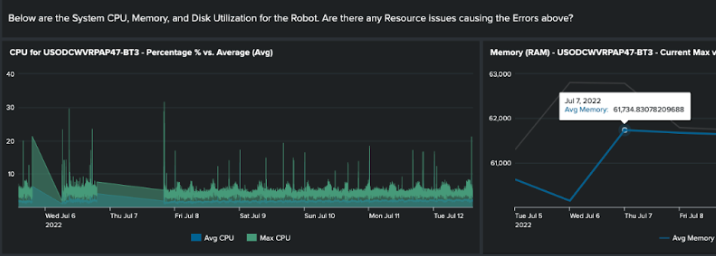Monitoring Robotic Process Automation (RPA) systems
Robotic Process Automation (RPA) is achieved through AI-powered software that can interface with any system just as a human would. With optical character recognition (OCR) screen reading powered by AI, you can apply RPA to do repetitive tasks that are time consuming and error prone. RPA holds huge benefits in terms of helping to automate business processes and improve efficiency. However, since RPA bots operate with target systems just like a human does, they should be treated with the same level of audit and security.
Different personas within your organization have different needs for information and insights relating to RPA systems:
- Chief Information Officers (CIO) will want to understand how many working hours and how much money is being saved from the RPA investment, learn whether the platform is being utilized to its maximum capacity, and what opportunities exist to grow the number of business units investing in the solution.
- RPA Circle of Excellence (CoE) teams will want to understand how many bots are running and reporting errors to exceptions, whether more teams can be taught to automate with the solution, and whether the platform as a whole is reliable and can support further automations.
- IT Operations will want to understand whether provisioning and capacity planning estimates are correct, whether bots have the right network connectivity to access target systems, and whether the RPA databases are scaled and reliable.
- Security teams will want to understand if any bots are compromised, access audit trails of system activity, view bot permissions, and understand whether bots are using usernames, passwords, dynamic tokens, or other secure methods to access target systems.
How to use Splunk Software for this use case
You can keep your RPA bots running automations reliability with UiPath Robotic Process Monitoring (RPM) for Splunk. The app provides a full closed-loop data integration with the UiPath API. You can immediately trigger actions in UiPath based on data in Splunk indexes. This could be restarting bots, jobs, or triggering new automations to kickoff based on any event. The app contains out-of-the-box visual dashboards and alerts into every RPA bot transaction.
The app includes a multitude of dimensions for your deployment including views into bots, queues, jobs, and exceptions. Data is displayed on a time series with correlation to other data points, helping you find and fix any issue in fewer than three clicks, with statistics all the way down to the raw logs for developers to remediate.
The screenshots below show the CoE Bot Insights dashboard, which provides high-level information you can use as a starting point. From here you can aggregate all bots to see full deployment, or select individual bots to get detailed information.
From the CoE Insights page, click any bot to investigate more closely. Further down the page, you can correlate system resources like CPU, memory, or disk that might be causing bot issues. You can view error counts by half hour and RPA exception annotation overlays. A sliding time picker over the time series also shows any detailed messages from UiPath in that time slice.


After you have investigated the error, you can make the data actionable by setting up alert actions that trigger when any type of data is found in the Splunk platform. This means you can take action within UiPath based on errors, key value pairs, or anything in your data to restart, reboot, and trigger new automations in UiPath. You can use this to trigger level 1 remediation playbooks or notifying another person for them to take action via UiPath Job.
Next steps
These resources might help you understand and implement this guidance:

